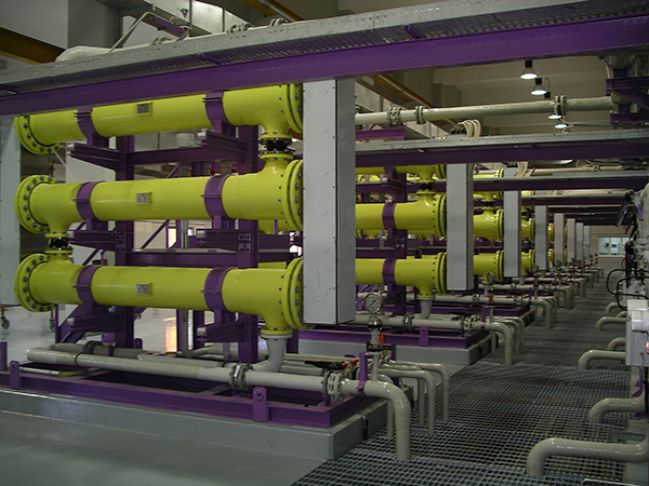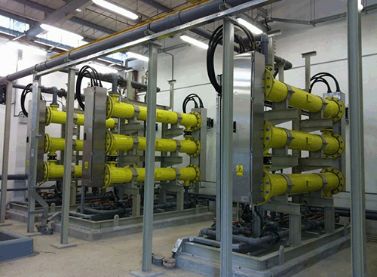SEACLOR systems for onshore installation use a simple and straightforward process, using only seawater and electricity. This proven process eliminates the purchase, handling, and storage of hazardous chemicals.
SEACLOR systems include electrolytic cell assemblies of modular construction combined in an electrical and hydraulic series. Electrodes are coated with De Nora’s patented DSA® formulations tailored to perform with different water temperatures and chloride concentrations.
SEACLOR® Onshore Seawater Biofouling Control systems
SEACLOR® onshore seawater biofouling control systems provide incomparable biofouling control in power plants, cooling towers, liquefied natural gas (LNG) terminals and desalination facilities, as well as coastal installations using seawater for cooling or other process needs all over the world.
Unique Design / Advanced Engineering
Reliability / Equipment Longevity
Easy to Operate and Maintain
Superior Biofouling Control
Why SEACLOR Onshore Seawater Biofouling Control systems?

SEACLOR seawater electrochlorination systems are designed and assembled for continuous and unattended operation requiring minimal remote monitoring. Typical transport and handling limitations have also been considered to minimize customer logistics during project execution and when extraordinary maintenance is needed.
- Robust and Flexible Design: The SEACLOR product boasts a proven track record with thousands of successful installations worldwide. Its robust and reliable design ensures long-lasting performance. Additionally, it offers operational flexibility, allowing operators to adjust production based on seasonal variations in marine growth. This flexibility also helps minimize hypochlorite discharge into the sea, promoting environmental sustainability.
- Effective and Reliable Treatment: De Nora SEACLOR technology excels in hazardous marine and corrosive environments. It delivers effective and reliable prevention of biofouling, ensuring optimal performance even in challenging conditions. This makes it a trusted solution for various onshore applications, providing enhanced reliability and safety.
- User-Friendly Operation and Low Maintenance: SEACLOR systems are designed for ease of use, making them simple for operators to manage and control. Minimal maintenance requirements further contribute to its user-friendly nature, reducing downtime and optimizing productivity. The long cell operating life of at least 5 years ensures the reliable and consistent production of chlorine, with minimal operating cost and efficient prevention of algae growth in the water circuits where the produced sodium hypochlorite is injected.
De Nora Seawater Electrochlorination System Successes
As the world leader for seawater electrochlorination technology for 40+ years, De Nora has more than 1200 installations in 60 countries, producing over 1.3 million kilograms per day of sodium hypochlorite from seawater, equaling 60-70% of the world capacity.
De Nora Seawater Electrochlorination System Successes
As the world leader for seawater electrochlorination technology for 40+ years, De Nora has more than 1200 installations in 60 countries, producing over 1.3 million kilograms per day of sodium hypochlorite from seawater, equaling 60-70% of the world capacity.
A liquified natural gas plant in Middle east
A power plant in Europe
Want to learn more about SEACLOR® systems?
How do Onshore Seawater Biofouling Control Systems Work?
The whole process is based on the electrolysis of seawater as it flows through an unseparated electrolytic cell. Pressurized seawater is delivered to the SEACLOR system where it is filtered to remove suspended solids larger than 0.5mm before entering into the cells. The seawater is forced through a flow control assembly that ensure optimum control of speed and volume of the seawater, entering the electrolyzer cells and exiting as sodium hypochlorite solution as a result of the current applied to the electrodes. This two-phase solution is piped to a tank where hydrogen gas is vented to atmosphere with the help of a blower. Finally, the sodium hypochlorite solution is injected as required either continuously and/or with shock-dose rates.
Standard SEACLOR systems range in capacity starting at 480 kg/day to 21,600 kg/day (1058 lb/day to 47,620 lb/day) per train with higher capacities achieved by adding trains.
Our state-of-the-art seawater electrochlorination systems ensure effective biofouling control by continuously injecting hypochlorite into the water. With a targeted dosage range of 1 to 2 ppm (for seawater temperatures above 10º C), SEACLOR guarantees comprehensive biofouling management in most scenarios, complemented when required by intermittent shock dosing or superchlorination with amount up to 5/7 ppm.
Our onshore seawater systems offer superior biofouling control capabilities while effectively addressing a wide range of seawater impurities.
Brochure
Applications & Markets
*De Nora manufactures devices for the in-situ production of disinfectants. Disinfectants can only be manufactured, placed on the market and used in the European Union exclusively on the basis of an authorization issued under Regulation 528/2012 and/or under the national legislation in force in each Member State. Contact De Nora to receive more information on regulatory compliance status of the specific equipment in your region.



